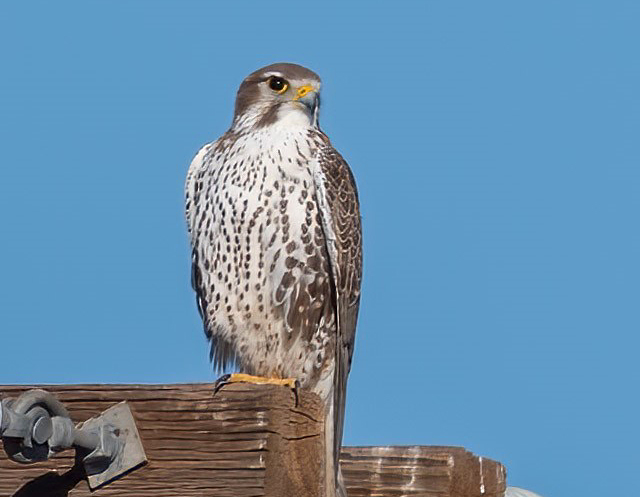A December Morning with Raptors in the Santa Cruz Flats
By Dan Weisz

Ferruginous Hawk, all photos by Dan Weisz
The Santa Cruz Flats are a great place to find wintering raptors in southern Arizona. I spent a December morning "on the Flats" and saw some really nice birds there. The last raptor we saw was perhaps the bird-of-the-day. This is a young Ferruginous Hawk, the largest soaring hawk in the US, about two feet long with a wingspan of 4.5 feet. That very white breast and large mouth are clear signs of a Ferruginous Hawk. The gape is the fleshy area at the base of the bill where the upper and lower mandibles meet. Basically, on this species, it looks like its mouth runs all the way back as far as the eye is.
Younger raptors seem to “stick” to their perches more than an adult bird would. So during these winters, an adult Ferruginous Hawk might fly from its perch before you get within a quarter mile of it. A younger, first year raptor may remain on the perch even if you park your car 25 yards from it and get out to take a photo. Once this Ferruginous Hawk did fly, it circled over us before heading away. That’s another different behavior than an adult would demonstrate. The younger Ferruginous Hawks are very lightly colored under their wings. In the field, this was a snowy white bird.
One of the birds I always hope to see in The Flats during winter is the Crested Caracara. As soon as we arrived that morning we observed a few of these birds interacting with Common Ravens on the ground. Here is one adult with its dark feathers, bright orange facial skin, and the light blue bill. You can see the feathers on its head that form its “crest”.
Compare the bird above with the other bird in the photo below. The new bird is a youngster. It could be a first year bird or perhaps a second year bird. Its dark feathers are more brown than black. Its facial skin is still white and pinkish. The white feathers on the bird above are still a dusty brown in the young bird below.
The young bird seems to be walking gingerly but this is just a function of the timing of the photo. Behind the birds, you can see a recently plowed field of cotton. When the farmers plow the fields, especially at the end of the cotton harvest, many invertebrates are exposed to the surface for caracara, ravens and other birds to scavenge. Also, rodents and lizards and other vertebrates may be injured by the plows, providing more easy food for the birds.
At one point the ravens moved to a different spot and the adult Caracara flew over to see what the attraction was. It didn’t want to miss any good food that might have been found. With the Caracara in landing position in the air, its beautiful tail is evident as are the white “windows” on its wings.
A Northern Harrier sped by hunting for prey.
Along one dirt road, a nice Red-tailed Hawk was perched on the top of a small mesquite tree. It was looking towards the farm fields to its left, then would fly ahead of us as we drove down the road. It landed on mesquite tree after mesquite tree as it kept flying and perching ahead of us.
A Prairie Falcon was perched on a telephone pole crossbeam. Prairie Falcons, as their name implies, are falcons of the West’s wide-open spaces (such as prairies). They can be found in any open, treeless space in the west including shrubby deserts and grasslands. Prairie Falcons are large falcons that have a prominent brown mustache stripe along with a white eyebrow.
The Prairie Falcon took off shortly after we stopped our car. The Prairie Falcon’s long pointed wings stretched up as it powered off the pole. You can see intent and purpose in the bird’s flight. It knows where it is headed and is going to get there very quickly. This shot gives a hint at another of the Prairie Falcon’s features. Under its wings, the feathers show a dark “armpit”. Other falcons do not have that plumage pattern.
Pinal County’s agricultural areas and the desert flats known as Santa Cruz Flats are a great home for wintering raptors every year.
Dan Weisz is a native Tucsonan and retired educator who enjoys birding, being in nature, and taking photographs.









Comments
Post a Comment
Thanks, we value your opinions! Your comment will be reviewed before being published.